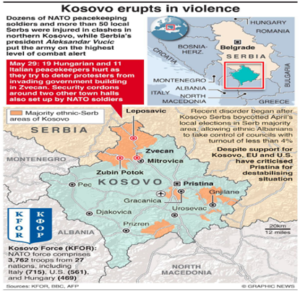Context:
After the escalation of tensions between Kosovo and Serbia in at least a decade, the North Atlantic Treaty Organization (NATO) recently sent 700 more of its peacekeeping troops to Kosovo.


Image Source: The Hindu
Timeline of the issue:- 12th Century: The Serbian Empire gains control of Kosovo.
- 1389: Serbia lost Kosovo for 500 years to the Ottoman Empire in the 1389 Battle of Kosovo.
- During the Ottoman Rule, the ethnic and religious balance shifted in Kosovo, leading it to become a majority ethnic Albanian region with Muslims.
- Early 20th Century: Kosovo becomes part of Serbia.
- Post-World War II: Kosovo is made an autonomous province within Serbia.
- 1989: Serbia strips Kosovo of its autonomy.
- Late 1990s: The Kosovo Liberation Army (KLA), consisting mainly of Kosovo Albanians, leads an insurgency against Serbian rule in Kosovo.
- 1999: NATO intervenes by carrying out air raids and bombardment of Serb targets, forcing Serbia to end hostilities and withdraw from Kosovo. NATO deploys 50,000 peacekeepers.
- 2008: Kosovo unilaterally declares independence from Serbia.
- Both Kosovo and Serbia lie in the Balkans, a region of Europe made up of countries that were once a part of the erstwhile Republic of Yugoslavia.
- The International Court of Justice (ICJ) ruling determined that Kosovo’s declaration of independence was not against international law.
- Kosovo is recognized as an independent country by approximately 100 nations, including the United States and several EU member countries.
- However, Serbia does not recognize Kosovo’s sovereignty and still considers it part of its territory.
- Kosovo’s bid for United Nations membership requires Serbia’s approval, but this is unlikely due to Serbia’s diplomatic allies, Russia and China, who would likely veto such a decision.
Post Views: 226
